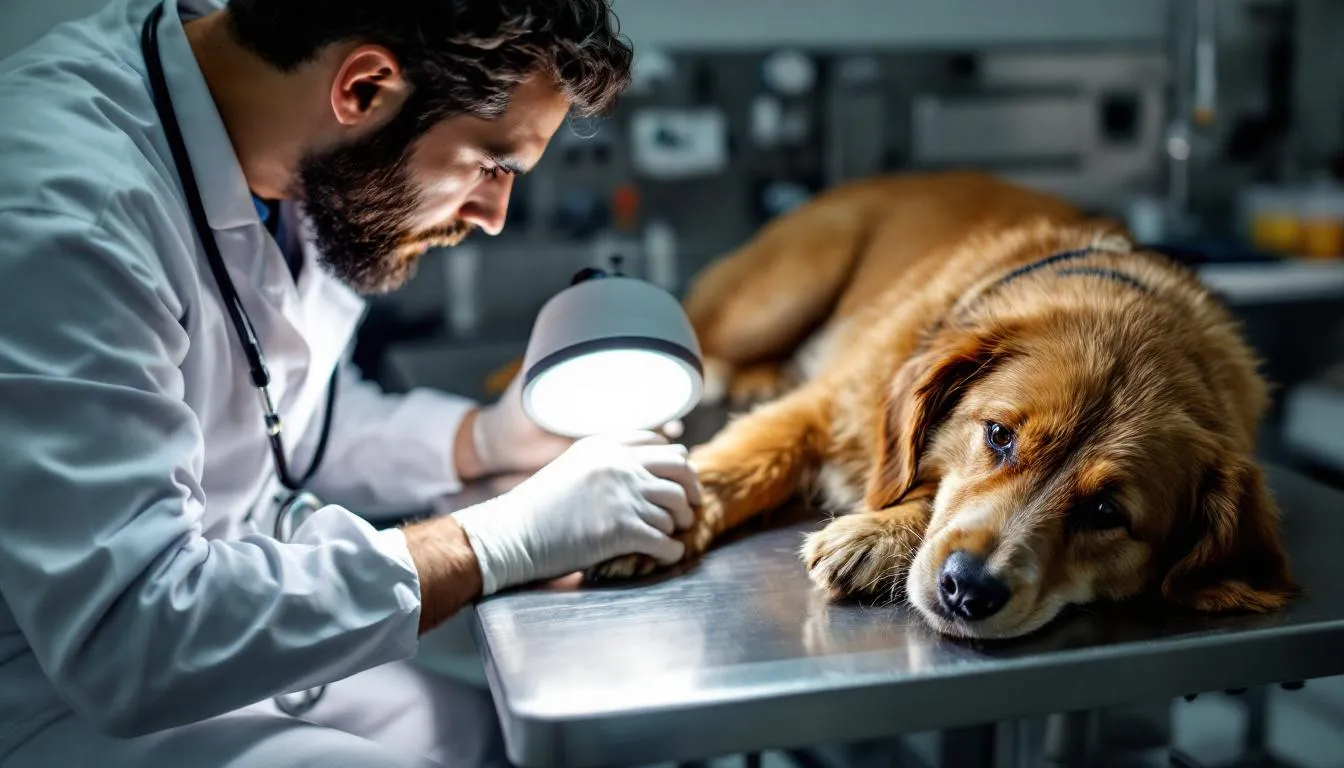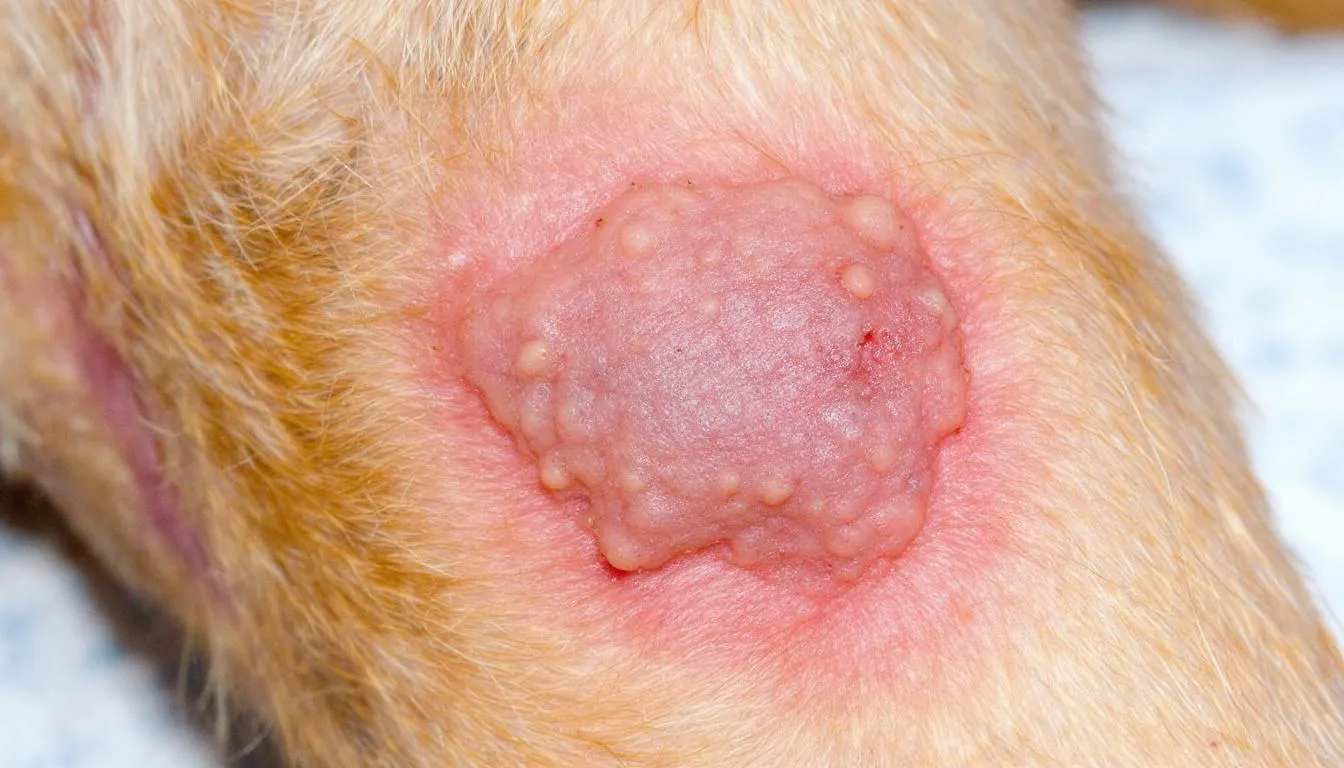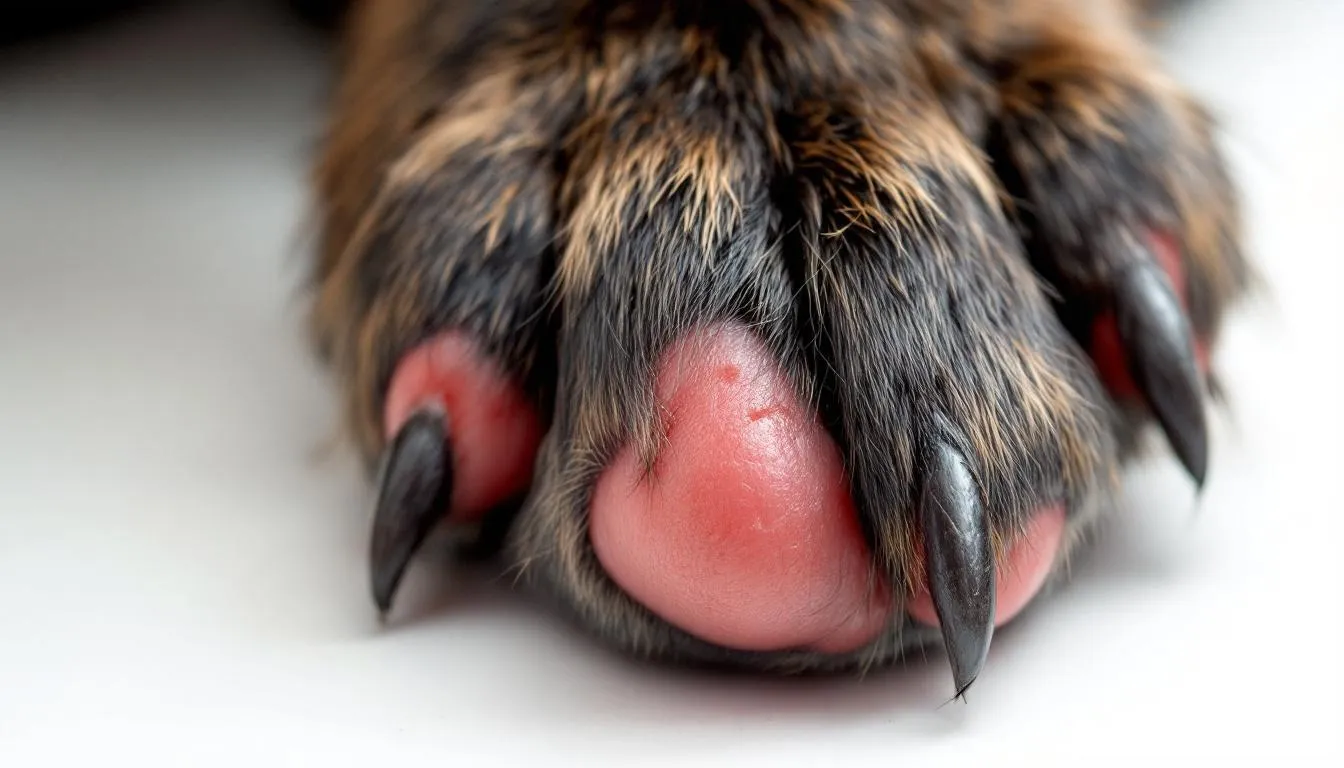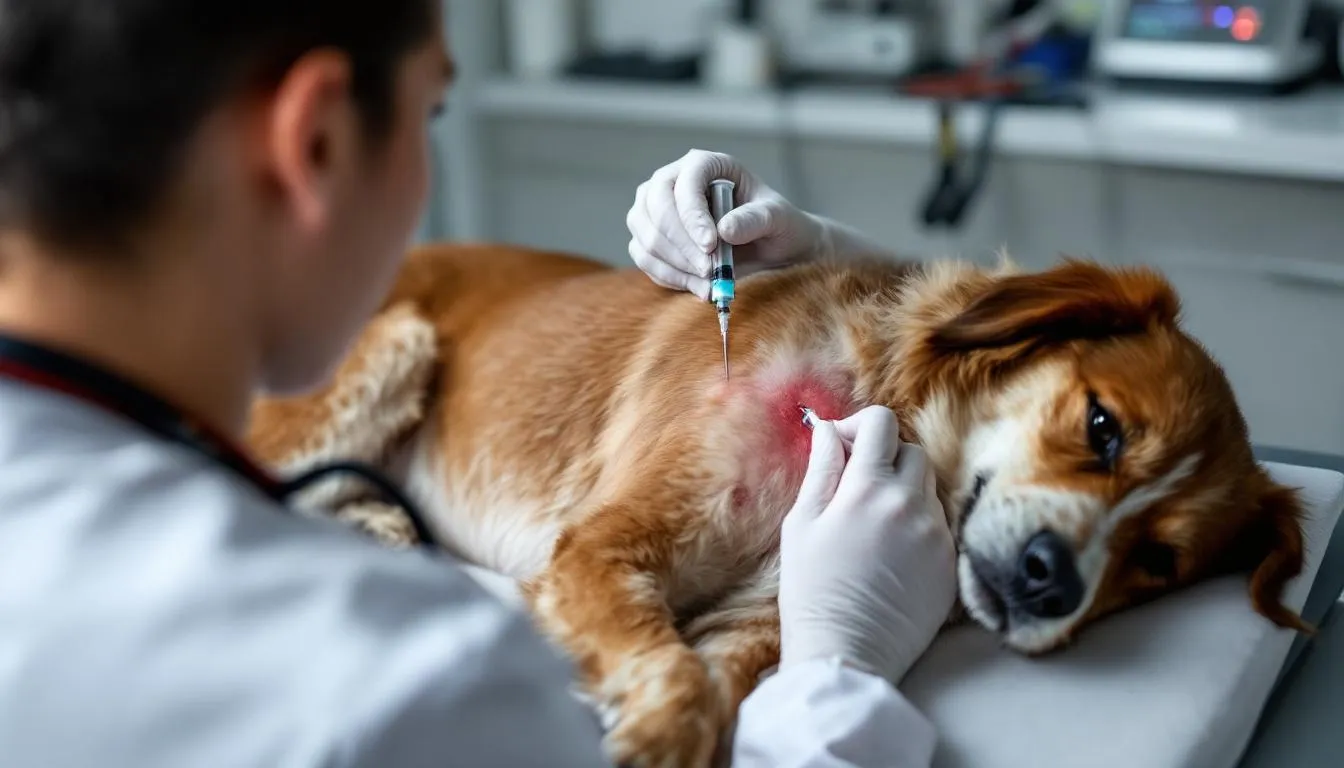Key Takeaways
- Skin tumors are the most commonly diagnosed cancer in dogs, with 60-80% being benign, but all new lumps should be evaluated by a veterinarian
- Mast cell tumors are the most common malignant skin cancer, especially affecting breeds like Boxers, Golden Retrievers, and Boston Terriers
- Early detection and surgical removal significantly improve treatment outcomes, with many skin cancers being curable when caught early
- Certain breeds have genetic predispositions to specific skin cancers, and sun exposure increases risk in light-colored or short-haired dogs
- Diagnosis requires veterinary evaluation through fine needle aspiration or biopsy, as appearance alone cannot determine if a tumor is cancerous
Skin tumors are the most commonly diagnosed cancer in dogs, with 60-80% being benign, but all new lumps should be evaluated by a veterinarian
Mast cell tumors are the most common malignant skin cancer, especially affecting breeds like Boxers, Golden Retrievers, and Boston Terriers
Early detection and surgical removal significantly improve treatment outcomes, with many skin cancers being curable when caught early
Certain breeds have genetic predispositions to specific skin cancers, and sun exposure increases risk in light-colored or short-haired dogs
Diagnosis requires veterinary evaluation through fine needle aspiration or biopsy, as appearance alone cannot determine if a tumor is cancerous


Understanding Skin Cancer in Dogs
Skin cancer in dogs involves the abnormal growth of skin cells that can develop into tumors affecting your dog’s skin and underlying tissues. Understanding the distinction between benign tumors and malignant tumors is crucial for every dog owner. Benign tumors remain localized and don’t spread to other parts of the dog’s body. Benign tumors are non-invasive and do not spread, while malignant tumors are cancerous tumors that can invade surrounding tissues and metastasize.
Statistics reveal that skin tumors represent the most commonly diagnosed cancer type in dogs, accounting for approximately one-third of all canine cancers. However, the encouraging news is that 60-80% of these skin tumors are benign. Among the most common skin tumors in dogs are mast cell tumors, lipomas, and histiocytomas, with certain types being more prevalent in specific breeds or age groups. The challenge lies in the fact that appearance alone cannot predict whether a tumor is malignant or benign, making veterinary evaluation essential for any new growth on your dog’s skin.
The complexity of skin cancer arises from the fact that different layers of skin can develop distinct types of tumors. The skin contains various cell types, including skin cells in the epidermis, connective tissue in the dermis, immune cells like mast cells, and specialized structures such as hair follicles and sebaceous glands. Hair follicle tumors can also develop in dogs and may be benign or malignant. Each of these components can potentially develop into different types of cell tumors.
In some cases, the dog's body may react to tumor contents as foreign substances, sometimes causing inflammation or other health issues.
Dog’s Skin Health
A dog’s skin is not only their largest organ but also a vital indicator of their overall health. Keeping your dog’s skin healthy is essential for preventing a range of issues, including the development of skin cancer. Skin tumors—both benign and malignant—can arise from a variety of causes, such as genetics, sun exposure, and even certain viral infections. While benign tumors are non-cancerous and often harmless, malignant tumors like mast cell tumors and squamous cell carcinomas can pose serious risks if not addressed promptly.
Regular veterinary check-ups are a cornerstone of maintaining your dog’s skin health. These visits allow for early diagnosis of skin cancer, which is crucial for successful treatment. Veterinarians commonly use fine needle aspiration and tissue biopsy to diagnose skin tumors and determine whether they are benign or malignant. For example, malignant melanomas are aggressive and require immediate attention, often involving surgical removal and, in some cases, radiation therapy.
Some breeds, such as Boston Terriers and Scottish Terriers, are genetically predisposed to developing certain types of skin cancer. Additionally, dogs with light-colored skin or those who spend a lot of time outdoors are at increased risk of developing skin cancer due to sun exposure. It’s important for owners of these higher-risk dogs to be especially vigilant about monitoring their pet’s skin.
Being proactive about your dog’s skin health means watching for warning signs such as unusual lumps or bumps, changes in skin color or texture, and any bleeding or discharge. If you notice any of these symptoms, prompt veterinary evaluation is essential. A veterinary pathologist can examine tissue samples to accurately diagnose the type of skin tumor and recommend the most effective treatment plan.
Treatment for skin cancer in dogs often starts with surgical removal of the tumor, which is frequently curative for many skin tumors if caught early. In cases where the tumor is in a difficult location or has spread, radiation therapy or chemotherapy may be necessary to manage malignant tumors and improve your dog’s prognosis.
By staying informed and working closely with your veterinarian, you can help ensure your dog receives the best possible care. Early diagnosis, regular monitoring, and a comprehensive treatment plan are key to managing skin-related issues and supporting your dog’s long-term health.


Common Types of Skin Cancer in Dogs
Understanding the five main types of skin cancer that commonly affect dogs helps owners recognize potential warning signs and understand treatment approaches. Each type has distinct characteristics, breed predispositions, and treatment protocols.
Other common skin tumors in dogs include basal cell carcinoma, which is a malignant tumor that often appears as a firm, raised mass and can spread locally, and sebaceous adenomas, which are benign tumors of the oil glands that typically appear as small, wart-like growths. Sebaceous adenoma is a specific type of benign oil gland tumor, and multiple sebaceous adenomas can develop over time, especially in certain breeds. Some tumors, such as low grade tumors, are less aggressive and have a better prognosis when completely excised. Certain skin tumors are more common in male dogs, and castration may be considered as part of the treatment for specific tumor types.
Mast Cell Tumors
Mast cell tumors represent the most common malignant skin cancer in dogs, comprising approximately 20% of all skin tumors. These tumors develop from mast cells, which are immune cells primarily involved in allergic reactions and immune responses throughout the dog’s body.
Certain breeds show increased susceptibility to mast cell tumors, particularly Boxers, Golden Retrievers, Boston Terriers, and Pugs. The typical age of diagnosis ranges from 8-10 years, though these tumors can affect dogs of any age. Mast cell tumors can appear anywhere on the body but commonly develop on the limbs, chest, and lower abdomen.
What makes mast cell tumors particularly concerning is their ability to release histamine and other inflammatory substances. When mast cells release histamine, they can cause allergic-like symptoms including swelling, redness, and itching around the tumor site. Some dogs may also develop stomach ulcers due to histamine release affecting their digestive system.
Diagnosis of mast cell tumors typically begins with fine needle aspiration, where collected cells are examined under a microscope. This procedure can usually diagnose mast cell tumors definitively. Treatment centers on surgical removal of the entire tumor with wide margins. The veterinary pathologist then grades the tumor, which determines whether further treatment with chemotherapy or radiation therapy is necessary. Confirmed mast cell tumors require careful staging to determine if malignant mast cells have spread to local lymph nodes or other organs.
Melanoma
Most cutaneous melanomas in dogs are actually benign, unlike their human counterparts. These tumors more commonly develop in dark-pigmented skin and tend to affect breeds such as Miniature Schnauzers and Scottish Terriers. Benign melanomas typically appear as small brown or black masses on the dog’s skin.
However, malignant melanomas represent a more serious concern. These aggressive tumors commonly affect the lips, mouth, and nail beds. When malignant melanoma affects the nail bed or nail beds, it can cause nail loss and potentially damage the underlying bone. The tumor location significantly influences both treatment approach and prognosis.
Malignant melanoma melanomas tend to spread rapidly to lymph nodes and internal organs, making early diagnosis and aggressive treatment essential. Treatment for malignant cases includes surgical removal, chemotherapy, and increasingly, immunotherapy approaches that stimulate the dog’s immune system to fight the cancerous cells.
Squamous Cell Carcinoma
Squamous cell carcinoma represents a relatively rare form of skin cancer in dogs, but it’s often linked to sun exposure and ultraviolet radiation. This cancer typically affects light-skinned areas or regions with sparse hair coverage, making certain breeds more susceptible.
Higher risk breeds include Dalmatians, Bull Terriers, Beagles, and Bloodhounds. Most squamous cell carcinomas develop in areas with pink skin that receives direct sun exposure. The tumors appear as firm, raised, ulcerated plaques or wart-like nodules that may bleed or become infected, leading to secondary infection.

Early diagnosis is crucial for successful treatment of squamous cell carcinomas. Treatment involves surgical removal of the primary tumor and surrounding tissue, often combined with radiation therapy for tumors in challenging locations. Dogs diagnosed and treated early have a good prognosis, with many living over 2.5 years post-diagnosis when caught early.
Histiocytic Cell Tumors
Histiocytic cell tumors encompass three main types affecting dogs: histiocytomas, cutaneous histiocytosis, and malignant histiocytosis. Histiocytomas commonly affect young dogs under 3 years of age and often resolve spontaneously without treatment.
Higher risk breeds for histiocytic cell tumors include Scottish Terriers, Bulldogs, Boxers, and Chinese Shar-Pei. While benign histiocytomas typically affect younger dogs, malignant forms tend to affect older dogs and carry a poor prognosis due to their aggressive nature and tendency to spread.
Diagnosis requires fine needle aspiration or tissue biopsy, as these tumors can be challenging to identify based on appearance alone. The collected cells help distinguish between benign and malignant forms, which is crucial for determining appropriate treatment approaches.
Fibrosarcoma
Fibrosarcoma develops from connective tissue and typically presents as a slow-growing tumor affecting middle-aged to older dogs, with an average age of 10 years at diagnosis. This cancer shows breed predisposition in Gordon Setters, Irish Wolfhounds, Golden Retrievers, and Dobermans.
While fibrosarcoma rarely metastasizes to distant organs, it can aggressively invade nearby connective tissues and structures. These tumors may cause bleeding or become infected, requiring prompt veterinary attention. Unfortunately, fibrosarcoma has a high recurrence rate after surgical removal, often requiring additional radiation treatments or more aggressive surgical approaches.


Signs and Symptoms of Skin Cancer
The most common sign of skin cancer is a visible change in your dog’s skin, particularly the appearance of new lumps or bumps. However, many skin tumors can present with various symptoms that every dog owner should recognize.
Key warning signs include:
- Sores that do not heal within a reasonable timeframe
- Changes in existing lumps, including alterations in size, shape, color, or texture
- Bleeding or ulceration of masses
- Swollen lymph nodes, particularly in areas near suspicious growths
- Gray or pink lumps that appear suddenly or grow rapidly
Sores that do not heal within a reasonable timeframe
Changes in existing lumps, including alterations in size, shape, color, or texture
Bleeding or ulceration of masses
Swollen lymph nodes, particularly in areas near suspicious growths
Gray or pink lumps that appear suddenly or grow rapidly
Systemic symptoms may also develop, especially with certain tumor types. Mast cell tumors can cause loss of appetite and weight loss due to histamine release affecting the dog’s digestive system. Dogs with digit tumors may experience nail loss or swollen toes, and tumors affecting the nail bed can cause significant discomfort.
Any mass that remains present for longer than a month or grows larger than a pea requires immediate veterinary evaluation. Your dog's lumps should be monitored regularly, and it is important to document any changes with photos. This helps veterinarians track the progression of your dog's lumps over time and identify potential health issues early.
Causes and Risk Factors
Understanding the causes and risk factors for skin cancer helps owners make informed decisions about prevention and early detection strategies. Genetic predisposition serves as the primary factor, with certain breeds showing significantly increased risk for specific tumor types.
Sun exposure and ultraviolet radiation represent major environmental risk factors, particularly for light-colored or short-haired dogs. Breeds with pink skin or sparse hair coverage face elevated risk when they engage in sunbathing behaviors or spend extended time outdoors during peak UV hours.
Environmental factors beyond sun exposure include exposure to chemicals, hormonal abnormalities, and certain viral infections, particularly papillomaviruses that can contribute to some skin tumor development. Age also plays a significant role, with most cancers affecting middle-aged to older dogs as cellular DNA damage accumulates over time.
Breed-specific genetic links have been well-documented for certain tumor types. For example, affects Bernese Mountain Dogs show increased susceptibility to histiocytic disorders, while Boston Terriers and other brachycephalic breeds demonstrate higher rates of mast cell tumors.


Diagnosis of Skin Cancer in Dogs
Accurate diagnosis of skin cancer requires professional veterinary evaluation, as visual examination alone cannot distinguish between benign and malignant tumors. Advances in veterinary medicine have greatly improved the ability to diagnose and treat skin cancer in dogs, making professional expertise essential for effective care. The diagnostic process typically begins with a thorough physical examination of any persistent, growing, or changing lumps.
Fine needle aspiration represents the most common initial diagnostic tool. This minimally invasive procedure involves inserting a small needle into the tumor to collect cells for microscopic evaluation. The collected cells provide valuable information about tumor type and malignancy potential.
For cases requiring more detailed information, veterinarians may recommend a tissue biopsy to obtain larger tissue samples. This procedure sometimes requires anesthesia but provides more comprehensive information about tumor characteristics and grade.
A veterinary pathologist examines the tissue sample or collected cells to provide definitive diagnosis and grading information. This analysis determines tumor type, degree of malignancy, and likelihood of spread or recurrence.
Additional staging tests may include chest X-rays, ultrasound, CT, or MRI to detect potential spread to internal organs. Regional lymph node aspirates help determine if cancerous cells have spread to the lymphatic system. Blood tests assess overall health and organ function, ensuring the dog can safely undergo planned treatments.
Treatment Options for Skin Cancer
Treatment approaches for skin cancer depend on multiple factors including tumor type, stage, tumor location, and the dog’s overall health status. Many skin cancers are treatable and curable when caught early, emphasizing the importance of prompt veterinary intervention.
Surgical Treatment
Surgical removal serves as the first-line treatment for most accessible skin tumors. For benign tumors, complete surgical excision is typically curative. However, malignant tumors require wide surgical margins, typically 2-3 centimeters beyond the visible tumor borders, to ensure complete removal of potentially cancerous cells.
In cases involving digit tumors, amputation may be necessary to achieve complete removal and prevent local recurrence. While this may seem drastic, dogs typically adapt well to digit amputation and maintain excellent quality of life.
Post-surgical histopathology confirms whether complete removal was achieved and guides decisions about further treatment. If tumor cells extend to surgical margins, additional therapy may be recommended.
Chemotherapy
Chemotherapy uses drugs specifically designed to target rapidly dividing tumor cells. These medications can be administered intravenously or orally, depending on the specific protocol and tumor type. Chemotherapy is particularly valuable for cancers that have spread to multiple locations or when metastasis is suspected.
While chemotherapy can cause side effects including nausea and low energy, most dogs tolerate treatment well with appropriate supportive care. Chemotherapy is often combined with surgery or radiation therapy for comprehensive treatment approaches.
Radiation Therapy
Radiation therapy targets tumors in areas where surgical removal is difficult or when surgical margins are incomplete. This treatment modality is particularly useful for tumors near sensitive structures or in locations where wide surgical margins aren’t feasible.
Radiation treatments are often combined with surgery or chemotherapy for optimal outcomes. However, some cancer types, particularly certain melanomas, may resist radiation therapy, requiring alternative treatment approaches.
Immunotherapy
Immunotherapy represents an exciting advancement in cancer treatment, utilizing vaccines and other approaches to stimulate the dog’s immune system to recognize and attack cancerous cells. This treatment is particularly promising for select cancers like malignant melanomas.
Immunotherapy is usually combined with other treatment modalities and may help shrink tumors while prolonging survival times. Research continues to expand immunotherapy applications for various skin cancer types.
Prognosis and Recovery
The prognosis for dogs with skin cancer varies significantly depending on tumor type and stage at diagnosis. Benign tumors generally don’t affect life expectancy and can often be completely cured with surgical removal. Many malignant tumors caught in early stages can also be removed safely with minimal impact on the dog’s lifespan.
However, aggressive malignant tumors diagnosed in advanced stages may significantly reduce life expectancy. This stark difference emphasizes why early detection and treatment are so crucial for optimal outcomes.
Post-surgery care includes appropriate pain medication and restricted activity to promote proper healing. High-quality nutrition supports recovery during treatment and helps maintain the dog’s strength throughout the healing process.
Regular monitoring for recurrence remains essential even after successful treatment. Many dogs require periodic recheck examinations and imaging studies to ensure the cancer hasn’t returned or spread to new locations.
Prevention and Early Detection
While genetic factors cannot be controlled, several environmental risk factors can be managed to reduce skin cancer risk. Limiting sun exposure, particularly during peak UV hours between 10 AM and 4 PM, helps protect susceptible dogs from ultraviolet radiation damage.
For light-colored or short-haired pets at high risk, dog-safe sunscreen can provide additional protection. However, only sunscreens specifically formulated for dogs should be used, as many human sunscreens contain ingredients toxic to pets.
Regular skin examinations during grooming sessions allow owners to monitor all masses for changes in size, shape, color, or bleeding. Establishing a routine of checking the dog’s skin helps ensure early detection of new growths or changes in existing lumps.
Understanding breed-specific risks enables targeted surveillance for early detection. Owners of high-risk breeds should be particularly vigilant about skin changes and maintain regular veterinary checkups focused on dermatological health.
The key principle remains that while genetic factors cannot be controlled, environmental factors can be managed through awareness and proactive care strategies.
FAQ
Can skin cancer in dogs be fatal?
Some malignant skin tumors can indeed be fatal if left untreated, particularly aggressive types like high-grade mast cell tumors and malignant melanomas that spread to internal organs. However, many skin cancers are completely curable with early detection and appropriate treatment, emphasizing the critical importance of prompt veterinary evaluation.
How quickly does skin cancer spread in dogs?
The spread rate varies dramatically by tumor type. Mast cell tumors and malignant melanomas can metastasize rapidly, sometimes within weeks to months, while other cancers like fibrosarcomas rarely metastasize but may recur locally. Squamous cell carcinomas typically spread more slowly, giving owners and veterinarians more time for effective treatment when detected early.
Should I be worried about every lump on my dog?
While 60-80% of skin tumors are benign, any new lump should be evaluated by a veterinarian since appearance alone cannot determine malignancy. Even experienced veterinarians cannot reliably distinguish between benign and malignant tumors without diagnostic testing, making professional evaluation essential for any persistent growth.
Are certain dog breeds more prone to skin cancer?
Yes, specific breeds have well-documented genetic predispositions to particular skin cancer types. Breeds like Boxers, Golden Retrievers, and Boston Terriers face higher risks for mast cell tumors, while light-colored breeds such as Dalmatians and Bull Terriers are more susceptible to sun-related cancers. Understanding these breed-specific risks helps owners maintain appropriate vigilance.
How much does skin cancer treatment cost for dogs?
Treatment costs vary widely depending on tumor type, treatment approach, and geographic location. Simple surgical removal of benign tumors may cost several hundred dollars, while comprehensive treatment including surgery, chemotherapy, or radiation therapy can range from several thousand to over ten thousand dollars. Many veterinary oncology centers offer payment plans or can discuss treatment options that fit different budget constraints.
FAQ
Can skin cancer in dogs be fatal?
Some malignant skin tumors can indeed be fatal if left untreated, particularly aggressive types like high-grade mast cell tumors and malignant melanomas that spread to internal organs. However, many skin cancers are completely curable with early detection and appropriate treatment, emphasizing the critical importance of prompt veterinary evaluation.
How quickly does skin cancer spread in dogs?
The spread rate varies dramatically by tumor type. Mast cell tumors and malignant melanomas can metastasize rapidly, sometimes within weeks to months, while other cancers like fibrosarcomas rarely metastasize but may recur locally. Squamous cell carcinomas typically spread more slowly, giving owners and veterinarians more time for effective treatment when detected early.
Should I be worried about every lump on my dog?
While 60-80% of skin tumors are benign, any new lump should be evaluated by a veterinarian since appearance alone cannot determine malignancy. Even experienced veterinarians cannot reliably distinguish between benign and malignant tumors without diagnostic testing, making professional evaluation essential for any persistent growth.
Are certain dog breeds more prone to skin cancer?
Yes, specific breeds have well-documented genetic predispositions to particular skin cancer types. Breeds like Boxers, Golden Retrievers, and Boston Terriers face higher risks for mast cell tumors, while light-colored breeds such as Dalmatians and Bull Terriers are more susceptible to sun-related cancers. Understanding these breed-specific risks helps owners maintain appropriate vigilance.
How much does skin cancer treatment cost for dogs?
Treatment costs vary widely depending on tumor type, treatment approach, and geographic location. Simple surgical removal of benign tumors may cost several hundred dollars, while comprehensive treatment including surgery, chemotherapy, or radiation therapy can range from several thousand to over ten thousand dollars. Many veterinary oncology centers offer payment plans or can discuss treatment options that fit different budget constraints.






